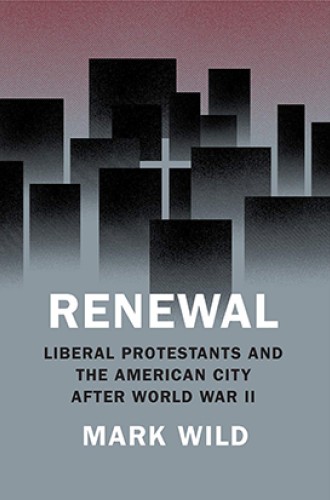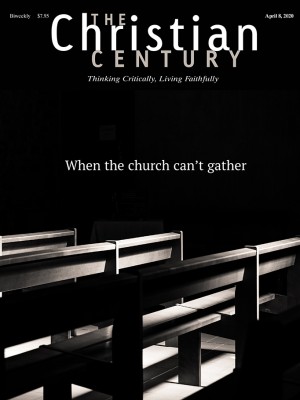How mainline Protestants got involved in urban renewal
Mark Wild complicates the conventional account of postwar white flight.
One of the major story lines in the history of 20th-century American Christianity is the flight of white Protestants from cities. The modern metropolis had always made them uneasy. Between its saloons and brothels, its sprawling working-class immigrant neighborhoods, and its offer of something approaching anonymity, the city seemed to many, from the very beginning, like a torpedo headed straight for godly order.
A change of heart appeared possible in the early 20th century, as surging grassroots movements helped middle-class Social Gospelers gain a wider audience for their vision of the redeemed city. But the fires of reform cooled in the wake of World War I and, as the Great Migration of African Americans from the South to northern and western cities proceeded apace, white Protestants hightailed it to the suburbs, catalyzing a devastating withdrawal of human and financial resources from city centers. Or so the story goes.
Read our latest issue or browse back issues.
Mark Wild’s new book complicates this vein of conventional wisdom by underscoring that, even in the heyday of suburbanization, a number of mainline Protestants continued to pour their hearts and souls into urban neighborhoods. For these renewalists, as Wild calls them, the stakes of city ministry could not have been higher: the future of both church and nation seemed to hang in the balance.
This was especially true in the early postwar years, when a generation of mostly young, white, male, middle-class clergy threw themselves into the middle of struggles over desegregation, union organizing, and more. Along the way they forged partnerships between urban and suburban churches, building influence through upstart institutions. One such institution, the Presbyterian Institute of Industrial Relations, trained more than 3,000 clergy and seminary students in the decades following World War II. These Christians then fanned out from its New York City headquarters to become engaged in labor struggles all across the country.
One of the many virtues of Wild’s book is its geographical range. He weaves developments in Harlem, San Francisco, Detroit, and countless other places into a compelling narrative of midcentury mainline urban reform.
Notably, renewal was never just a project undertaken by white Christians. Wild highlights the story of San Francisco’s Church for the Fellowship of All Peoples, which flourished under Howard Thurman’s remarkable leadership in the 1940s and 1950s, showing forth the promise of interracial ministry. And Thurman was hardly alone. As the years passed, more and more clergy of color took charge of renewalist initiatives, mobilizing resistance to top-down urban redevelopment proposals and taking advantage of new funding streams generated by the War on Poverty.
But for all its diversity, the renewal movement never found an easy way to navigate the swirling crosscurrents of race. White participants’ zeal for racial justice was frequently paired with a conspicuous lack of experience working in and with communities of color. And while some black and brown clergy were interested in pursuing integrationist visions, others were wary of the all-too-small step from white involvement to white control.
Developments at the Methodist Inner City Parish in Kansas City, Missouri, illustrated larger trends. While white suburban volunteers initially helped to power the church’s revitalization, their enthusiasm plummeted when the church’s black minister, Phil Lawson, opted to cosponsor programs with the local Black Panther chapter and issued scathing criticisms of “racist white officers” in the United States military. In short order, the regional Methodist conference cut off support. “A defiant Lawson described the move as a blessing, because now it was no longer beholden to whites,” Wild reports.
Renewalist anxieties and fissures sprang from a variety of other sources too. The movement was, even at its peak, driven and defined—both for better and for worse—by doubt. Deeply shaped by neoorthodoxy’s critique of earlier liberal theology, mainline reformers believed in the importance of the church and yet fretted incessantly about the inadequacy of churchly institutions. Such overarching worries formed the backdrop for more particular debates.
One centered on the appropriateness of Christian involvement in conflictual modes of social change. While some renewalists argued for explicit endorsement of organized labor, others worried that such a step would undermine the larger mission, which in their view required constructive relationships with management too.
These philosophical disagreements only intensified as Saul Alinsky’s adversarial community-organizing strategies came to the fore at midcentury. The question of whether to partner with Alinsky’s Industrial Areas Foundation, which sought to increase working-class power in urban neighborhoods across the country, was related to yet another quandary facing renewalists, namely, what was the role of the church versus that of secular organizations in advancing reform in a pluralistic society?
As much as renewalists loved the former, many gravitated over time into the latter, a trend that siphoned energy away from the church-adjacent institutions that had long been the beating heart of renewal. By the 1970s, with the momentum of the postwar revival flagging and questions about the best use of increasingly scarce mainline resources mounting, the movement began to dissipate altogether.
Wild’s impressively documented account of the renewalist tradition is not a beach read, but it represents an exciting addition to the new history of the mainline. Over the course of the last generation, as scholars hastened to unearth the religious roots of a resurgent Republican Party, their narratives focused overwhelmingly on evangelicalism. This attention continues to generate important insights. But it has also tended to obscure the fact, so clearly in evidence here, that the mainline remained a force to be reckoned with well into the late 20th century.
Twenty-first-century mainliners will find few straightforward lessons in the story of the renewal movement. Its internal tensions and contradictions were manifold. And yet this weakness was, without a doubt, a product of one of renewalists’ greatest strengths: they took seriously the irreducible complexities of both their call to reform and the urban context in which it took shape. In that sense, if their legacy does not include much in the way of best practices, it may be because a deeper wisdom was at work.
A version of this article appears in the print edition under the title “Faith in the city.”






